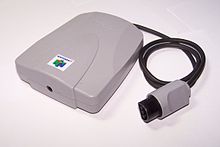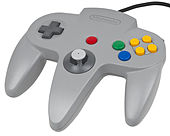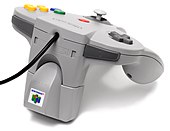Nintendo 64
The Nintendo 64 (proper spelling: NINTENDO64, officially abbreviated as N64, jap.: ニンテンドウ64, Hepburn: Nintendō Rokujūyon), named after its 64-bit main processor, is Nintendo's third stationary game console released worldwide. It is the successor to the Super Nintendo Entertainment System (SNES) and the first game console with a 64-bit architecture. It was first released in Japan on June 23, 1996, in North America on September 29, 1996, and in Europe on March 1, 1997. As a game console, it competed mainly with Sony's PlayStation and Sega's Saturn, but could only beat the latter console in terms of sales.
In Germany, the console was launched at a price of 399 Deutsche Marks, but was reduced to 299 Deutsche Marks after eight weeks. At launch, only the two launch titles Super Mario 64 and Pilotwings 64 were available in Germany, followed by other games a few weeks later.
Nintendo promoted the device at release as the fastest video game system on the market. The 64-bit architecture of the processor was especially emphasized, the competing consoles PlayStation and Sega Saturn only worked with 32 bits. The actual advantages in games with the 64-bit architecture were however rather to be classified as marginal, whereby the advantage with arithmetic computations is worth mentioning. The efficiency of the processor at that time is also worth mentioning, since theoretically 4 bytes can be processed with one instruction. As storage medium for the games, modules (so-called Game Paks) were used, as already with Nintendo's predecessor consoles. By eliminating the need for an expensive CD drive, the console could be manufactured and offered at a lower price, allowing Nintendo to achieve the maximum starting price of $250. The modules offered shorter load times compared to the Sony and Sega consoles, which used CD-ROMs, but very little storage space and were also more expensive to produce. This was reflected in the high sales prices for the games compared to the competitors.
The controller of the Nintendo 64, the Nintendo 64 Controller, introduced as a significant innovation a modernized, digital variant of the analog stick, which in the meantime had gone out of fashion, allowing for more precise control, especially in 3D games. Another innovation was the Rumble Pak, which can be plugged into the controller and triggers vibration effects (force feedback) when special events occur in certain games. The analog stick as well as the vibration effect were adopted by controllers of subsequent consoles and also established themselves as a fixed standard in competitor products.
After being replaced in 2001 by its successor, Nintendo GameCube, the console continued to be manufactured until 2003. Worldwide, about 32.93 million units were sold - not even a third as many as the PlayStation. Super Mario 64 is considered the best-selling game of the N64, with about 11.9 million units sold worldwide.
Origin and development
The Nintendo 64 was initially developed from 1993 onwards in conjunction with workstation manufacturer Silicon Graphics under the project name "Project Reality" - which was later renamed "Ultra 64".
By using plug-in modules, the black copying problem should be avoided. In addition, long loading times were eliminated and the saving of game scores was possible directly on the module by means of a memory (battery-supported in some games). Compared to the CD-ROM, however, the production costs of the modules were much higher and due to the significantly lower storage capacity of only up to 64 MB (512 Mbit), it was hardly possible to integrate pre-rendered video and elaborate audio sequences into the games. For these and other reasons, such as the more complicated game programming, the Nintendo 64 was considered rather sparsely by game manufacturers from the beginning. The most famous developer in this regard is Square, which released its Final Fantasy series of role-playing games, which were especially important for the Japanese market, not for the Nintendo 64, but for the PlayStation. Nintendo itself, together with Rare, was by far the most important supplier of high-quality N64 games.
In 2001, software development for the Nintendo 64 ended after about 400 titles worldwide (including over 250 in Germany), about 225 million games sold, and nearly 33 million consoles sold. One of the last commercial successes was the game Paper Mario, which was also released in 2001.

Opened Nintendo 64 module
Extensions and peripherals
Controller
→ Main article: Nintendo 64 controller
The Nintendo 64's controller, a gamepad that fits onto one of the four ports on the console, has an unusual shape with three handles: The left handle features the directional pad and L-shoulder button used since NES days, the right handle features most of the ten buttons (noticeable: the four smaller C buttons), and the middle handle features the trigger-like Z-trigger button and a then-novel analog stick that most games made use of, as it allowed for sensitive control in 3D games. Due to the punctual springback of this analog stick, the risk of wear and tear was quite high if not handled properly. Especially in games of the Mario Party series, you had to turn the stick intensively in circles several times during the various mini-games, which inevitably led to a loss of power of the springback and deposition of abrasive material. For this reason, the analog stick suspension was changed for the successor console, the Nintendo GameCube, to minimize possible wear.
On the underside of the controller, a so-called Controller Pak can be used to save game scores or a Rumble Pak to create shake/vibration effects. The Controller Pak is not absolutely necessary for the Nintendo 64 because of the internal memory system. However, some manufacturers waived it so that some games require this Pak. Internally there is a 32 kilobyte SRAM chip of the type Toshiba TC55257DFL-85L and the necessary battery. The memory is divided into 128 pages, 123 of which are available for storing game saves, for which one to all 123 pages are needed, depending on the game. Regardless of how many pages are used, there is a limit of 16 saved game states per controller Pak.
Rumble Pak
The Rumble Pak was sold together with the game Lylat Wars in a bundle in 1997 and later also individually. This feature was copied by other manufacturers and is now standard in every console controller (except for the lack of Rumble function in the PS3 controller "Sixaxis" and the Wavebird controller for the Nintendo GameCube). Nintendo never offered a Pak that combined the functions of Rumble and Controller Pak, so at times the player was forced to choose between the Rumble effect and the save option - if a game did not support saving to the module. To get around this problem, later games gave players the option to swap Paks for a moment. Other manufacturers offered modules that could be switched between save and vibration, but this was not an optimal solution, as these modules did not work correctly with some games.
Expansion Pak
→ Main article: Expansion Pak
A special expansion is the Expansion Pak, which can be inserted into a small slot on the top of the console, increasing the RAM from 4 MB to 8 MB. In some games, this allows an optional higher texture size (called High-Resolution) to be selected, increasing the number of pixels from 320 × 240 to 640 × 480. However, the higher texture size requires more processing power, so you also get a lower refresh rate. For three titles (Donkey Kong 64, The Legend of Zelda: Majora's Mask and large parts of Perfect Dark) the Expansion Pak is even mandatory, which is why it was included with Donkey Kong 64. In order to use the Expansion Pak, you first have to remove the Jumper Pak, a kind of pseudo-module without additional RAM. In later bundles of the Nintendo 64, the Expansion Pak was already inserted and stuck with a sticker that says "Do not remove this label".
Transfer Pak
There was also the Transfer Pak from Nintendo for transferring Game Boy data into an N64 game. It has a slot itself, into which a Game Boy game module is inserted. This way a data exchange between GB and N64 module can take place. Only a few N64 games such as Pokémon Stadium as well as its successor Pokémon Stadium 2 used this feature. In Mario Golf and Mario Tennis, the Transfer Pak allowed the exchange of character data between Game Boy and Nintendo 64 versions of the respective game. Perfect Dark for Nintendo 64 also allowed cheats to be unlocked by connecting to the Game Boy version of the game.
Controller Pak
The Controller Pak was an accessory that, like the Rumble Pak and Transfer Pak, could be inserted into the slot on the back of the Nintendo 64 controller. It was a battery-powered memory module that could be purchased separately. This could be used to store data for selected games, identified by a special mark on the packaging. (e.g. Diddy Kong Racing, to save high score times).
Microphone Pak
Furthermore, the Microphone Pak for voice recognition and control in the Pokémon game Hey You, Pikachu! was only released in Japan and the USA. For this purpose, the voice recognition hardware ("Voice Recognition Unit" abbreviated VRU [NUS-020]) is connected to the fourth controller port of the Nintendo 64, while the actual microphone [NUS-021] is plugged into the Controller Pak slot on the bottom of the controller, but does not make an electrical connection there (the Japanese microphone is a headset). The VRUs are region-specific, and a VRU for the USA region cannot be used for Japanese games, and vice versa.

Voice Recognition Unit (VRU)

Controller Pak

Controller of the N64

N64 controller with Rumble Pak plugged in

Front and rear view of an Expansion Pak

Transfer Pak
Questions and Answers
Q: What was the Nintendo 64?
A: The Nintendo 64 (commonly abbreviated N64) was the third home video game console released by Nintendo. It was first released in Japan in June 1996 and was meant to compete against the Sony PlayStation and the Sega Saturn.
Q: How did it differ from other consoles?
A: The Nintendo 64 was Nintendo's first console made for 3D graphics, and it used plastic cartridges instead of CDs or disks, making load times faster.
Q: What did the controller look like?
A: The controller for the Nintendo 64 was shaped like an "M" and had 10 buttons and a joystick. Sony used the N64 joystick design to make their DualShock PlayStation controller.
Q: How much RAM did it have out of the box?
A: Out of the box, the Nintendo 64 had 4 MB of RAM, and it could be upgraded to 8 MB with an expansion pak.
Q: Why didn't many video game companies develop games for it?
A: Because making games for the Nintendo 64 was more expensive than making games for the PlayStation, many video game companies chose develop for the PlayStation instead. Additionally,Nintendo also did not like games that had a lot of blood or violence in them which further deterred some developers from creating titles on this platform.
Q: Did any violent games come out on this system?
A: Yes, some game makers did make some violent games for the Nintendo 64 such as Rare's first-person shooter Perfect Dark.
Q: When did production cease worldwide?
A: Production ceased in Japan in 2002 and worldwide in 2003
Search within the encyclopedia